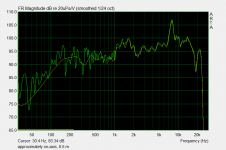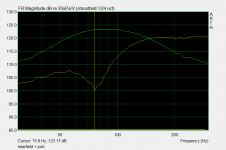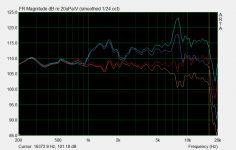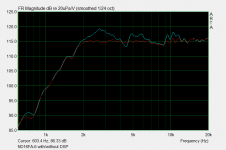First off, if anyone wants to find out why the heck I'm doing this, please read this thread. This is phase 1 of the experiment proposed in that thread. If you have questions or concerns about the premise, please post them there, not here.
This thread is strictly about taking some measurements of this driver, and then messing around with filters and tweeters and taking some more (and I will listen to music occasionally, of course).
To kick things off, here are a couple quick ones. The drivers are in the cheapo Fostex Kanspea boxes, and thoroughly broken in. We've got the 0.5 meter response, somewhere close to on-axis. Farther distances did not show significant changes, so I stuck with 0.5m for best psuedo-anechoic range. Looks to be in reasonable agreement with the published response, except for the obvious step down corresponding to the small baffle.
Also, even though it has little bearing on this experiment, we've also got a quick check of the nearfield bass to see what's happening with the little cabinet. Now, if I could just find a ****** protractor...
This thread is strictly about taking some measurements of this driver, and then messing around with filters and tweeters and taking some more (and I will listen to music occasionally, of course).
To kick things off, here are a couple quick ones. The drivers are in the cheapo Fostex Kanspea boxes, and thoroughly broken in. We've got the 0.5 meter response, somewhere close to on-axis. Farther distances did not show significant changes, so I stuck with 0.5m for best psuedo-anechoic range. Looks to be in reasonable agreement with the published response, except for the obvious step down corresponding to the small baffle.
Also, even though it has little bearing on this experiment, we've also got a quick check of the nearfield bass to see what's happening with the little cabinet. Now, if I could just find a ****** protractor...
Attachments
Horizontal 10-degree measurements (0-60°). If you haven't figured it out already, these are dual-gated measurements, so you see a transition to reflections being included at the low end. The 2-7k ripple that increases off-axis is also a reflection I accidentally left in, but its influence is nothing but that little ripple. Don't worry, I can be less sloppy when needed, just checking out the basics here.
Attachments
Last edited:
Considering how ragged the response, remarkably matched.Since these will be compared at some point, here are the two speakers. Looks like we have a match to me.
+13 dB at 8000, pretty "snappy".
Last edited:
Here's DSP used to EQ the driver. It took several rounds to get the treble sounding decent, but I think now I have it in the right neighborhood here. How's this sound? Well... it sounds okay. I don't know why ARTA isn't putting the color key at the bottom for me right now, but this is on-axis and 20 degrees off horizontal for each.
Attachments
I got all set up to do a 2-way at lunch, but there seems to be something wrong with the tweeter (see below). I'll try another one later.
Looks kind of like the inverse of the Fostex, did you remember to go back to flat after EQing the Fostex?
Hmm, I did not anticipate how tricky it would be to "voice" the speakers for a good 1-way EQ'd vs 2-way comparison. I mean, I didn't expect to just match the on-axis curves as close as possible and call it fair, but they need to be more different than I expected.
While I play around with that, you can admire my high tech rapid prototyping techniques:
While I play around with that, you can admire my high tech rapid prototyping techniques:
Attachments
Hey, at least your woofer box is wood. I had to make one out of cardboard to get a decent response out of a tweeter and woofer so I could measure them! 😀
I even used the same blue tape to tape the edge of the woofer frame. I was amazed at the reduction of diffraction!
I even used the same blue tape to tape the edge of the woofer frame. I was amazed at the reduction of diffraction!
After a little more work on EQing the Fostex alone, it's already clear that definitively besting it by adding a $10 tweeter is not going to be a simple task if unrestricted DSP is allowed, but I'm going to try.
It seems that the dispersion is becoming the subjectively dominant difference in sound as I get the 2-way and 1-way better matched, even when listening nearfield.
It seems that the dispersion is becoming the subjectively dominant difference in sound as I get the 2-way and 1-way better matched, even when listening nearfield.
Sounds just like predictions suggested. Single has high directivity and it is compensated with high level. A tweeter has wider directivity and more even spl. What size is your tweeter?
Can't be too big, perhaps 1.5". The FF105 is the 4" just below.
Like to use foam and coroplast for fast prototyping myself. Now where is my diffraction compensation clay 😉
What color protractor would you like? I have clear, white, smoke and fushsia lol 😀
Like to use foam and coroplast for fast prototyping myself. Now where is my diffraction compensation clay 😉
What color protractor would you like? I have clear, white, smoke and fushsia lol 😀
What crossover frequency are you trying?That's the 5/8" Dayton soft dome on there. I've also got 20mm and 1".
Did you prefer the Fostex over the Alpair?
3400 LR4 was the initial test, but hold yer horses. 🙂 Likewise, I haven't touched either Alpair driver yet. Once I've had enough DSP fun with the Fostex, I'm still going to do passive 1-way and 2-way filters for it too. THEN it's Alpair time.
Horizontal 10-degree measurements (0-60°). If you haven't figured it out already, these are dual-gated measurements, so you see a transition to reflections being included at the low end. The 2-7k ripple that increases off-axis is also a reflection I accidentally left in, but its influence is nothing but that little ripple. Don't worry, I can be less sloppy when needed, just checking out the basics here.
You might consider tipping the driver back. I put the same driver in something that resembled a Beolab lens, and it really worked out nicely. Here are my measurements on axis, 45 degrees off axis, and 90 degrees(!) off axis:
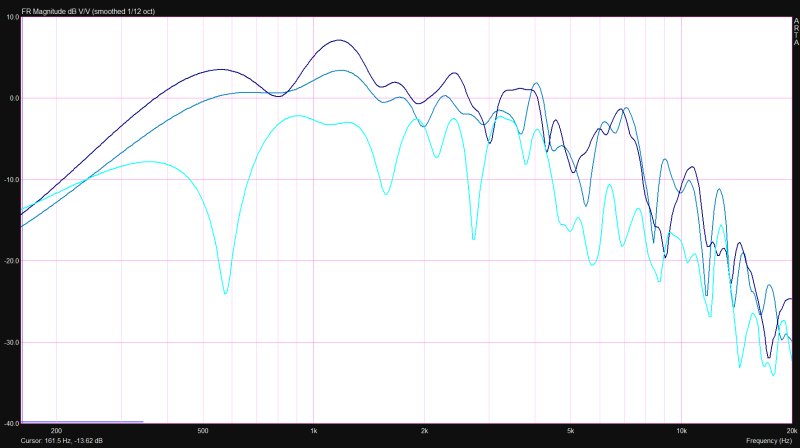
Here's your speaker from 0 to 60 degrees:
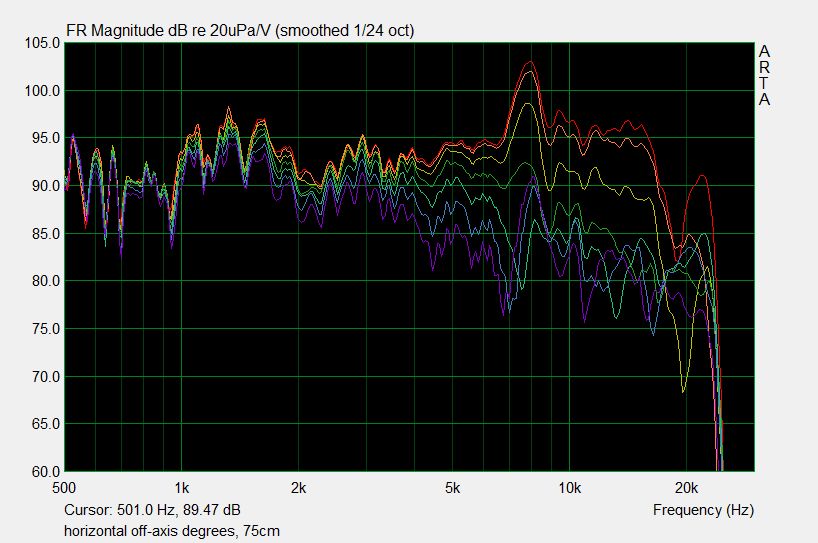
There's a video and some pics of it here:
http://www.diyaudio.com/forums/multi-way/239808-28-days-later-3.html#post3612828
That Fostex is really a nice driver. I think it was Planet10 that was singing it's praises about a year back, and he was right. To my ears, it *barely* needs a tweeter.

From looking at the way that the driver was designed, it seems to me that the aluminum radiator in the center of the cone is designed to act like a passive tweeter as frequencies get higher. Thiel used to do something similar a few years back:
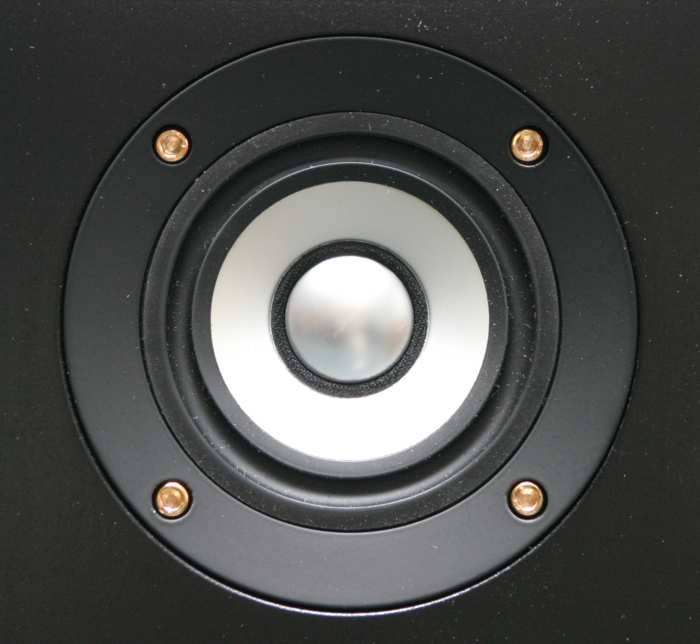
"The center 1" is the tweeter, with a small black rubber surround, then the midrange driver, and its surround. The crossover between the midrange and tweeter is mechanical rather than having capacitors and inductors in the signal path."
I know that whizzer cones are hardly a new invention, but it really requires some expertise and quality control to get it right. And to my ears, Fostex has done a really nice job with this one.
Last edited:
- Status
- Not open for further replies.
- Home
- Loudspeakers
- Multi-Way
- Fostex FF105WK Experiments
